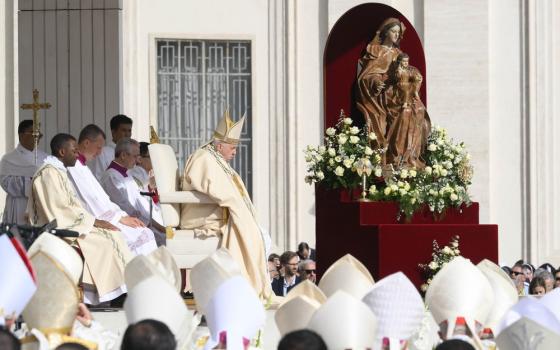A month-long nuclear arms control conference ended in discord May 22nd at the United Nations in New York as the United States rejected a move to allow a conference aimed at establishing a nuclear free zone in the Middle East.
However, the conference could likely be remembered as the gathering at which a majority of the world’s nations finally and unequivocally rejected nuclear weapons.
As the conference entered its final hours, the US blocked an Egyptian call for a nuclear free Middle East. Israel, a strong US ally and widely believed to have nuclear weapons, opposed the idea.
That final diplomatic rift received much of the attention as the conference ended, but it concealed a larger conference story: the moves by 107 nations, frustrated by the slow pace of disarmament, to sign a document calling for a legal ban of nuclear weapons.
The document, called the Humanitarian Pledge, is the result of many years of growing frustration among the non-nuclear possessing nations at the seeming unwillingness of the nuclear possessing nations to give up their weapons.
At a diplomatic level, the 2015 Nuclear Non-Proliferation Treaty (NPT) Review Conference will likely be viewed as a "failure"; among nuclear arms opponent activists, it could likely be seen as new moment of clarity and humanitarian resolve.
From the outset of the conference, arms control advocates expressed modest hope for any nuclear disarmament breakthrough. US and Russia have grown more hostile with each other. A 2010 nuclear treaty conference review action program to establish the Middle East as a nuclear free zone never got off the ground.
By terms of the 1970 treaty, which requires reviews every five years, the five signatory nuclear holding nations are pledged to disarm in exchange for non-nuclear possessing giving up ambitions to arm themselves with weapons. It’s been referred to as “the grand bargain.”
For more than three decades disarmament efforts preceded, stockpiles were cut. But then efforts slowed. No further disarmament negotiations are taking place. Meanwhile, the world’s stockpiles contain some 16,400 nuclear weapons, each weapon many times more powerful than those dropped over Hiroshima and Nagasaki in 1945.
Adding to arms control pessimism, each of the nuclear holding nations is “modernization” its arsenals The United Sates, for example, plans to spend a costly $1trillion in the next three decades. Last month the Arms Control Association, which monitors nuclear weapons, reported the US is seeking 1,000-1,100 new, nuclear-capable air-launched cruise missiles, part of its much larger nuclear sustainment plan.
With the five nuclear signatory nations widely viewed as paying lip serve to serious nuclear disarmament, the non-nuclear nations, peace advocates, civil, religious and medical groups arrived in New York last month visible frustrated. Their frustrations grew during the conference as nation after nation spoke about the “catastrophic” consequences of a single nuclear blast. The US, for its part, in document preparation on possible consequences, said it preferred the “severe” and not “catastrophic.”
One of the most widely talked about statements made during the conference occurred on May 13.th On that day a frustrated South African Ambassador Abdul Samad Minty challenged the nuclear club nations, asking, “When will we ever get nuclear disarmament?” South Africa, which is the only signatory nation to have given up its nuclear weapons, has special credibility at nuclear disarmament conferences.
Asked Minty rhetorically: “Why is it that only the security of the five [nuclear possessing nations] requires nuclear weapons, whilst no one else needs nuclear weapons for their security? If the truth is that no one’s security needs nuclear weapons, then all of our security is enhanced by getting rid of nuclear weapons. If this is indeed the case, what makes it so different for the five that they feel that they have to be exempted from this universal truth?”
He said there is a difference between nuclear disarmament and nuclear reduction. “The concept of reduction,” he said, “means that we do not need so many and therefore we will reduce some. The concept of nuclear disarmament means that we must carve out a path for the total elimination of nuclear weapons.”
“If nuclear disarmament is the direction and in this so-called roadmap this is the path that NWS [Nuclear Weapon States] are taking, they need to tell us, what roadmap they are working on? How fast are they going on this road? At what rate they are traveling and how long will it take to reach the destination? Do they need some fuel from us to make them go faster or are they taking rest stops along the way, or are they simply lost?”
“If we are to look at the roadmap and claim that reductions are the way to nuclear disarmament, then when will we reach that destination? Is it so elusive that none of the NWS know when we will reach it? Or is that a secret that cannot be shared with us, despite its centrality to increasing our own security?
He concluded, saying it is time for a “legally binding framework” to achieve nuclear disarmament. “This is not to say that such a framework could be agreed at this conference, nor implemented immediately. However, we need to discuss how to create that framework, because we are all in the same world and we suffer the same destiny as a result of the actions of some of us.”
Twice during the conference the names of 159 countries were read out as countries that had agreed nuclear weapons should never be used again, under any circumstances. During the conference the nuclear armed nations repeatedly sought to legitimize their arsenals, arguing they remain necessary to avoid nuclear war, but the majority refused to go along with this thinking. Non nuclear possessing nations repeatedly stated that nuclear arsenals can never be legitimate. As the divide grew deeper, the backbone of the majority of the world’s nations -- those advocating some kind of new move or document to push the nuclear disarmament process forward -- seemed to stiffen.
As the final days, then final hours, of the conference grew near, it became clear there would be no consensus document. The nuclear possessing signatory nations – US, Russia, England, France and China – resisted calls for aggressive new disarmament measures. Meanwhile, the non-nuclear possessing nations began circulating a document calling for precisely such disarmament.
“Some states expect us to play by the rules they don’t play by themselves,” the South African ambassador said, echoing a the more popular view that the planet is experiencing what delegates called “nuclear colonialism.”
By the end of the conference momentum had grown substantially for a clear statement calling for the prohibition and elimination of nuclear weapons. It had been a grassroots insurrection under the noses of the seemingly hapless nuclear nations. As the conference ended late Friday, 107 nations of the 159 at the conference had signed the document, called the “Humanitarian Pledge.”
The pledge traces its origins to three international conferences held in the past three years on the humanitarian effects of a nuclear exchange. Projected consequences alarmingly were found to be far more devastating than studies had found to that point.
Beatrice Fihn, Executive Director of International Campaign to Abolish Nuclear Weapons (ICAN), May 22nd said that since “the nuclear weapon states are not interested in making any new commitments to disarmament, so now it is up to the rest of the world to start a process to prohibit nuclear weapons by the 70th anniversary of the atomic bombings of Hiroshima and Nagasaki.” The world will commemorate the 70th anniversary this August.
She described the Humanitarian Pledge as reflecting “a fundamental shift in the international discourse on nuclear disarmament over the past five years,” calling it, “the latest indication that governments are preparing for diplomatic action after the review conference.” ICAN is a coalition of more than 400 non-governmental organizations in 95 countries.
Austria, in the final session said that exchanges of views witnessed during the review conference confirmed “a wide divide” between the nuclear and non-nuclear nations. It spoke of “a reality gap, a credibility gap, a confidence gap and a moral gap.”
Austria has been a leading advocate to ban nuclear weapons. It introduced what it called “the Austrian pledge” to make nuclear weapons illegal. However, as nations continued to sign it soon took on its current name, “the Humanitarian Pledge.”
The pledge calls on signatories “to cooperate with all relevant stakeholders, states, international organizations, the International Red Cross and Red Crescent Movements, parliamentarians and civil society, in efforts to stigmatize, prohibit and eliminate nuclear weapons in light of their unacceptable humanitarian consequences and associated risks.”
Daryl G. Kimball, executive director of the Arms Control Association, which has tracked NFT review conferences since its first in 1975, at the close of the gathering the frustration most nations expressed at the slow pace of action on disarmament by the nuclear-armed states. He specifically cited the costs of these modernization efforts and their associated “dangerous nuclear doctrines.”
He summarized the gathering saying it had highlighted “a widespread concern about the catastrophic humanitarian consequences of nuclear weapons use and the need to act with greater urgency to eliminate nuclear dangers.”
Fox is NCR Publisher, can be reached at tfox@ncronline.org, and can be found on Twitter @NCRTomFox.



